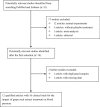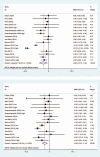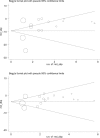The impact of grape seed extract treatment on blood pressure changes: A meta-analysis of 16 randomized controlled trials
- PMID: 27537554
- PMCID: PMC5370781
- DOI: 10.1097/MD.0000000000004247
The impact of grape seed extract treatment on blood pressure changes: A meta-analysis of 16 randomized controlled trials
Abstract
Backgrounds and objective: Several clinical trials have shown that grape seed extract can reduce blood pressure, but the results are often irreproducible. We therefore sought to systematically evaluate the impact of grape seed extract treatment on the changes of systolic/diastolic blood pressure (SBP/DBP) by meta-analyzing available randomized controlled trials.
Methods: Trial selection and data extraction were completed independently by 2 investigators. Effect-size estimates were expressed as weighted mean difference (WMD) and 95% confidence interval (CI).
Results: Twelve articles involving 16 clinical trials and 810 study subjects were analyzed. Overall analyses found significant reductions for SBP (WMD = -6.077; 95% CI: -10.736 to -1.419; P = 0.011) and DBP (WMD = -2.803; 95% CI: -4.417 to -1.189; P = 0.001) after grape seed extract treatment. In subgroup analyses, there were significant reductions in younger subjects (mean age < 50 years) for SBP (WMD = -6.049; 95% CI: -10.223 to -1.875; P = 0.005) and DBP (WMD = -3.116; 95% CI: -4.773 to -1.459; P < 0.001), in obese subjects (mean body mass index ≥ 25 kg/m) for SBP (WMD = -4.469; 95% CI: -6.628 to -2.310; P < 0.001), and in patients with metabolic syndrome for SBP (WMD = -8.487; 95% CI: -11.869 to -5.106; P < 0.001). Further meta-regression analyses showed that age, body mass index, and baseline blood pressure were negatively associated with the significant reductions of SBP and DBP after treatment. There was no indication of publication bias.
Conclusion: Our findings demonstrate that grape seed extract exerted a beneficial impact on blood pressure, and this impact was more obvious in younger or obese subjects, as well as in patients with metabolic disorders. In view of the small sample size involved, we agree that confirmation of our findings in a large-scale, long-term, multiple-dose randomized controlled trial, especially among hypertensive patients is warranted.
Conflict of interest statement
The authors have no conflicts of interest to disclose.
Figures



Similar articles
-
The effect of grape (Vitis vinifera) seed extract supplementation on flow-mediated dilation, blood pressure, and heart rate: A systematic review and meta-analysis of controlled trials with duration- and dose-response analysis.Pharmacol Res. 2022 Jan;175:105905. doi: 10.1016/j.phrs.2021.105905. Epub 2021 Nov 17. Pharmacol Res. 2022. PMID: 34798267
-
The Effect of Chia Seed on Blood Pressure, Body Composition, and Glycemic Control: A GRADE-Assessed Systematic Review and Dose-Response Meta-Analysis of Randomized Controlled Trials.Nutr Rev. 2025 Mar 1;83(3):448-465. doi: 10.1093/nutrit/nuae113. Nutr Rev. 2025. PMID: 39225983
-
The effects of grape seed extract on glycemic control, serum lipoproteins, inflammation, and body weight: A systematic review and meta-analysis of randomized controlled trials.Phytother Res. 2020 Feb;34(2):239-253. doi: 10.1002/ptr.6518. Epub 2019 Dec 26. Phytother Res. 2020. PMID: 31880030
-
Diastolic blood pressure reduction contributes more to the regression of left ventricular hypertrophy: a meta-analysis of randomized controlled trials.J Hum Hypertens. 2013 Nov;27(11):698-706. doi: 10.1038/jhh.2013.20. Epub 2013 Mar 28. J Hum Hypertens. 2013. PMID: 23535988
-
Effects of grape seed extract beverage on blood pressure and metabolic indices in individuals with pre-hypertension: a randomised, double-blinded, two-arm, parallel, placebo-controlled trial.Br J Nutr. 2016 Jan 28;115(2):226-38. doi: 10.1017/S0007114515004328. Epub 2015 Nov 16. Br J Nutr. 2016. PMID: 26568249 Clinical Trial.
Cited by
-
The Possible Role of Nutraceuticals in the Prevention of Cardiovascular Disease.High Blood Press Cardiovasc Prev. 2019 Apr;26(2):101-111. doi: 10.1007/s40292-019-00309-5. Epub 2019 Feb 27. High Blood Press Cardiovasc Prev. 2019. PMID: 30811011 Review.
-
Uncovering the promising role of grape pomace as a modulator of the gut microbiome: An in-depth review.Heliyon. 2023 Oct 6;9(10):e20499. doi: 10.1016/j.heliyon.2023.e20499. eCollection 2023 Oct. Heliyon. 2023. PMID: 37867799 Free PMC article. Review.
-
The effect of grape products containing polyphenols on oxidative stress: a systematic review and meta-analysis of randomized clinical trials.Nutr J. 2021 Mar 12;20(1):25. doi: 10.1186/s12937-021-00686-5. Nutr J. 2021. PMID: 33712024 Free PMC article.
-
The effects of grape seed extract supplementation on cardiovascular risk factors, liver enzymes and hepatic steatosis in patients with non-alcoholic fatty liver disease: a randomised, double-blind, placebo-controlled study.BMC Complement Med Ther. 2024 May 16;24(1):192. doi: 10.1186/s12906-024-04477-3. BMC Complement Med Ther. 2024. PMID: 38755622 Free PMC article. Clinical Trial.
-
Phenolic Analysis and In Vitro Biological Activity of Red Wine, Pomace and Grape Seeds Oil Derived from Vitis vinifera L. cv. Montepulciano d'Abruzzo.Antioxidants (Basel). 2021 Oct 27;10(11):1704. doi: 10.3390/antiox10111704. Antioxidants (Basel). 2021. PMID: 34829574 Free PMC article.
References
-
- Harrison DG, Gongora MC. Oxidative stress and hypertension. Med Clin North Am 2009; 93:621–635. - PubMed
-
- Pisoschi AM, Pop A. The role of antioxidants in the chemistry of oxidative stress: a review. Eur J Med Chem 2015; 97:55–74. - PubMed
-
- Li J, Liu H, Ramachandran S, et al. Grape seed proanthocyanidins ameliorate doxorubicin-induced cardiotoxicity. Am J Chin Med 2010; 38:569–584. - PubMed
-
- de Lange DW. From red wine to polyphenols and back: a journey through the history of the French Paradox. Thromb Res 2007; 119:403–406. - PubMed
Publication types
MeSH terms
Substances
LinkOut - more resources
Full Text Sources
Other Literature Sources
Medical

